In this extract from a talk just after the inauguration of Barack Obama, Thich Nhat Hanh draws parallels between a president’s task of uniting a nation and a meditator’s task of bringing their different elements into harmony. He invites us to rely on each other, both in our mindfulness practice and as citizens of a nation.
Excerpted from a Dharma Talk by Thich Nhat Hanh given in Vietnamese, on 22nd January, 2009 in Lower Hamlet, Plum Village, France, during the “Path of The Buddha” Winter Retreat on the theme of “global ethics.” Translated by Sister Lang Nghiem
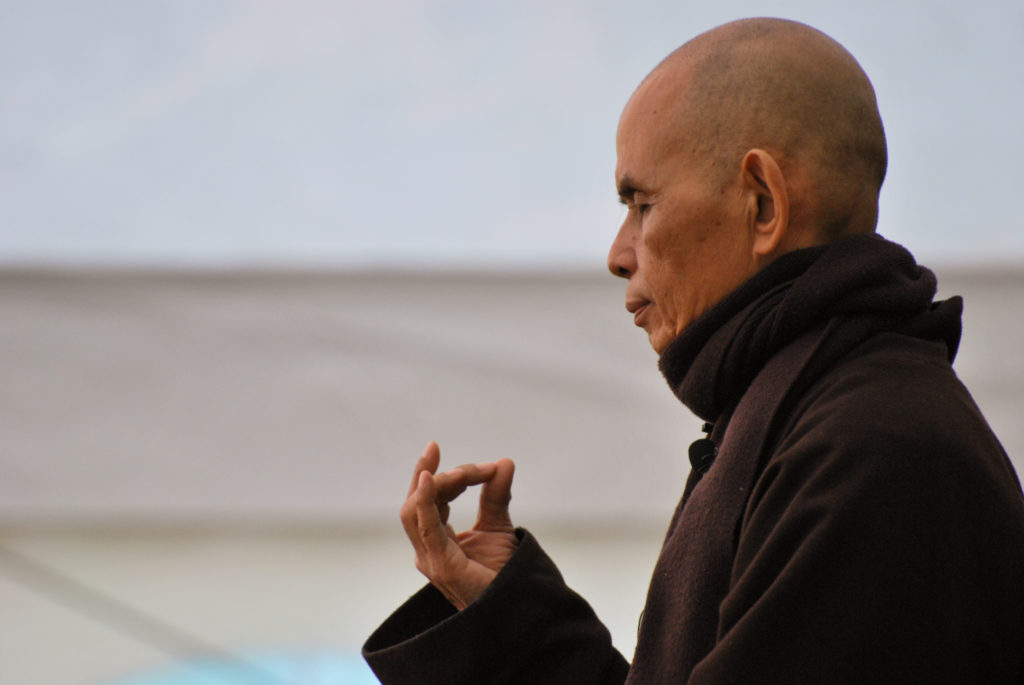
January 20th was a very joyful day for the United States of America. Barack Obama was sworn in as President. Journalists in Europe said that the whole nation is standing behind Obama. And that day proved that there is hope, there is a will to unite in rebuilding America.
The speech that President Obama gave after being sworn in was very similar to a Dharma talk. Everyone listening was as concentrated as they would be if they were listening to a teaching. In his speech we can also see the Four Noble Truths. Obama spoke about the difficulties and suffering of America, and the roots and causes of that suffering. And he spoke about hope: the hope that America can rise up and meet the new challenges facing the nation, to bring America and the world into a brighter era. Obama called on all citizens to let go of petty grievances, recriminations, and discrimination. In his speech we can clearly see the Four Noble Truths. And people listened and cried, as though they were parishioners listening to a sermon.
When I heard the French journalist say that all Americans were standing by their president, I immediately thought of our practice. We practice as an individual, as a family, as a couple, as a community, and as a nation. We can consider the 20th of January as a “day of mindfulness” for America. Everyone had the opportunity to come together to sit, to look deeply, and to listen.
As we go about our daily life, are our five skandhas behind us, fully supporting us, or are they divided?
First, let us speak about what we can do as an individual. We practice as an individual, but at the same time we practice as a community or a family. Each one of us is made of five elements which in Buddhism we call our five skandhas: our body, feelings, perceptions, mental formations, and consciousness. As we go about our daily life, are our five skandhas behind us, fully supporting us, or are they divided? Within our very own selves there may be division, antagonism, separation. If our five skandhas are not truly united, backing us up, we will feel weak and at odds with ourselves. Anxieties pull us in one direction; anger in another. Fears pull us one way; our cravings and habits pull us another. And then we have our mindfulness, the diligence of a meditator, trying to pull us in the direction of practice. So we should ask ourselves, Are our five skandhas fully behind us and supporting us? Or is there chaos, each element marching to a different beat, leading us to fail in our practice.
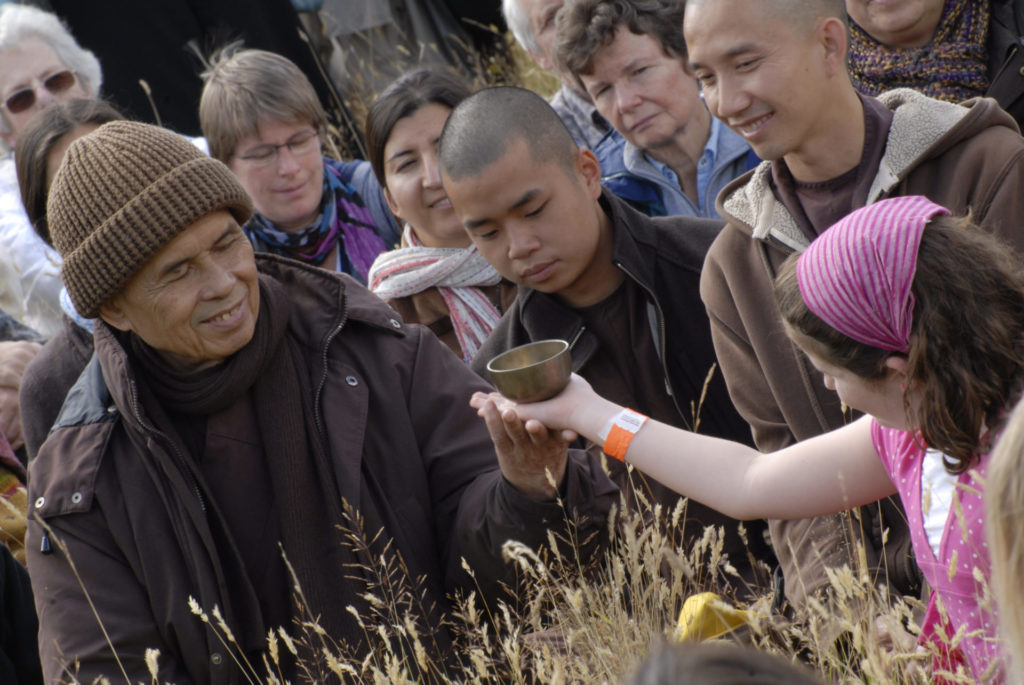
Our five skandhas are like a community. We have a song in Plum Village, where we sing: Sangha is my five skandhas, working in harmony. Sometimes our body, feelings, perceptions, mental formations and consciousness don’t cooperate; there is conflict and discord. They are at odds with each other; it troubles us and we suffer.
So the question is, how can we be like Obama, giving a great speech that can inspire the whole nation to listen, to have faith, and to stand behind the President? Obama was successful on day one. The whole nation is behind him. We should remember that a few days earlier, Obama praised Senator John McCain and had invited him and the Republican Party to join him in rebuilding America. That is very skillful. Because if the United States is divided, with the two parties so polarized, how can they do the work of rebuilding America as the American people wish? And so we have to invite those who have opposed us to come with us. And in our own bodies, it’s the same. We may have the desire, the will to practice, to transform, to reconcile, to be free, but in our Five Skandhas, there are factions that can’t agree, they’re pulling us in different directions, preventing us from going forward. So, as a practitioner, what can we do?
In Buddhism, we say that we have fifty-one different kinds of “mental formations,” and each mental formation wants attention. Our craving wants attention, our anger wants attention, our fear wants attention. Just like when everyone wants to speak at once, and wants everyone to agree with them. Everyone is speaking, yet no one wants to listen. In such a situation, what do we do? In Buddhism we speak of mindfulness, concentration and insight. How can we get all five skandhas to go in one direction? That is when we need concentration.
There is an American biologist called Lewis Thomas. He said every time he feels dispersed, when everything in him is marching to a different beat, music is the best way to bring all the disconnected parts into harmony. We listen to music and invite all our five skandhas to participate. That is the kind of mindfulness we practice in Plum Village. This morning before chanting, we invited the whole community to breathe as one body, chant as one body, listen as one body, and to go as a river and not as individual drops of water. When the whole sangha listens as one body, we enter a state of concentration. With concentration we can get a break through, an insight, a kind of liberation and peace.
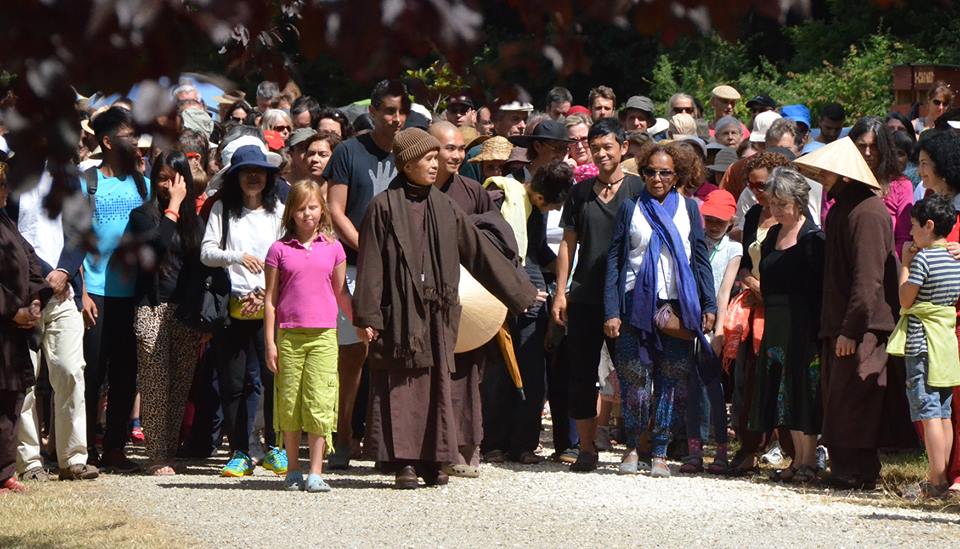
We have to overcome ourselves in order to achieve great things. If we simply allow our habits to prevail, it won’t be possible to remake America. That is the way, the path forward, to overcome the challenges ahead and to rebuild America.
When we train ourselves in mindful breathing, our breath becomes the kind of music that allows our mental formations and five skandhas to come together in harmony. While breathing in, we breathe in such a way that every the cells in our body participates in the in-breath. And when we breathe out, we breathe in such a way that every cell in our body can participate in that out-breath. Just like when President Obama was sworn in on Capitol Hill, everyone in America tuned in to listen.
While breathing in, we breathe in such a way that every cell in our body can participate. That is concentration. We don’t just breathe with our nostrils and our lungs and let other parts of our body do something else. If our in-breath is of good quality it has a rhythm, and it is a kind of music. In the Plum Village tradition we use key words (or gathas) to accompany our breathing, and some of them we may sing silently in our mind. They can help us breathe as if we’re playing music and can help every cell in our body to participate and be in synchrony.
Lewis Thomas was correct when he said that the harmony depends on whether the music is good or not. One in-breath already has the capacity to bring about peace, happiness, and solidarity. Obama’s speech was able to capture the people’s attention and give them hope and faith in the future. But Obama has to continue this way of speaking and acting, because one speech given on one day is not enough. The same is true for us.
Every time we breathe-in, we have to breathe in such a way that all the cells in our body participate in the in-breath. Not only are the cells in our body are participating, but also our feelings, emotions, perceptions and consciousness. Breathing in, I know that I am breathing in. Not only is every cell participating, but also my perceptions and mental formations—including mindfulness, concentration, insight, contact and attention. There is a kind of contact while breathing in. There’s attention on the in-breath, there’s a perception about the in-breath, there is consciousness of the in-breath. So in one breath there is already contact, attention, feelings, perceptions, and volition (intention). Breathing in, our whole body and our whole mind participate in the breathing. If we want to be successful, we have to invest each of our five skandhas in our in-breath. I can breathe like that, and there are a people in the community who can breathe like that. What this means is that, while we’re breathing in, the breathing becomes the most important thing that is happening, and our entire being—from our body to our consciousness—participates. In the same way, only when all of America stands behind Obama, will he be successful.
Imagine someone playing the violin with a bow. The movement is continuous. In the same way, the in-breath continues the out-breath, uninterrupted. We can visualize a figure eight. As you breathe in your entire being is breathing in. And as you breathe out, your entire being is breathing out. The in-breath is a continuation of the out-breath; the out-breath is the continuation of the in-breath. So during sitting meditation, our breathing is music, that music is the full awareness of breathing (Ānāpānasati); the concentration. If the whole of America is standing behind Obama, for sure he will succeed. Americans might be behind Obama on day one, but what about day two or day three? If they can stand behind him for 100 days, they can achieve a lot, because the concentration will be very powerful.
Yesterday, Obama called the Prime Minister of Israel and the Prime Minister of Palestine to discuss peace in the Middle East. If during that call his voice was concentrated it would carry more weight. When we ourselves have the power of concentration, when our Five Skandhas are in harmony, every step, every breath can help us realize peace, joy and freedom, and can lead to transformation.
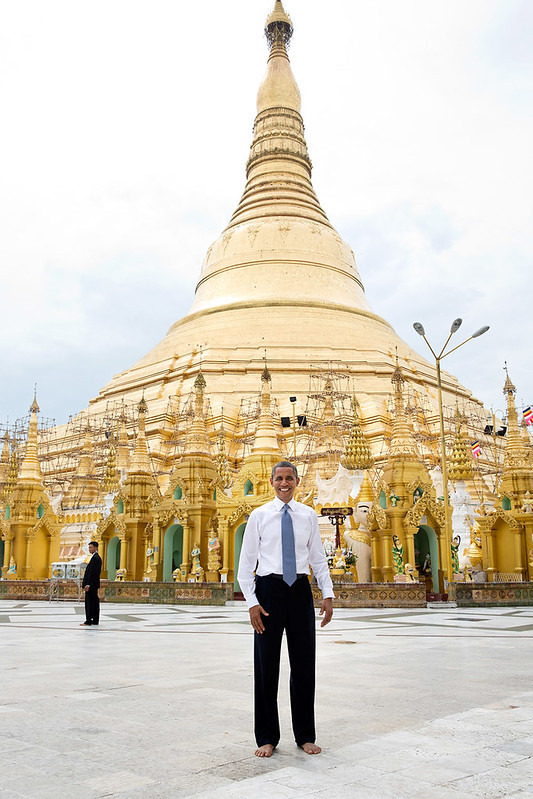
In Obama’s speech, he spoke about reforming bad habits: the habit of greed and indulgence, and the habit of protecting self-interest at the expense of the safety and happiness of others. He spoke of the need to change. Each one of us has these habit energies. Obama said that we have to “pick ourselves up and dust ourselves off.” We have to overcome ourselves in order to achieve great things. If we simply allow our habits to prevail, it won’t be possible to remake America. That is the way, the path forward, to overcome the challenges ahead and to rebuild America.
We know we have the capacity to make good, difficult, decisions, and yet somehow we keep putting it off.
We all have our habits and. We know we must be decisive and let go of them, but we hesitate and delay. We’re unwilling to them cut off. We know we have the capacity to make good, difficult, decisions, and yet somehow we keep putting it off. Take ending the war in Iraq, for example. Greed and craving causes great damage and suffering. Our way of consuming harms ourselves and others. And yet we can’t stop. We have the power to decide to stop, but we keep delaying it. President Obama said very clearly that we have to reexamine our economic, social and educational programs and whether they are meeting the needs of the people: to move forward with the programs that are working and have the courage to end those that are not, in order to make way for new programs. That is the spirit of the Fourth Noble Truth: the way out of suffering.
We ourselves also have weaknesses, habits, craving, and fears, and we’re afraid of being decisive. But we have to decide to let go of our damaging habits. And if we cannot do it alone we can rely on a community, a sangha. Alone we may not be able to do much, but together we can do it.
We cannot succeed if we only pursue our own success and prosperity, and not the well-being of others.
When we do walking meditation, we do our best to walk as a river. When a few hundred people do walking meditation together, we create a collective energy of mindfulness. Everyone is mindful, everyone is paying attention to their steps. That collective energy protects everyone in the sangha and penetrates each person. Just like migrating birds, flying in flocks of thousands. When they fly as a sangha, they expend much less energy than when they fly alone; they rely on each other. Scientists have discovered this in their research. We are the same. When we walk as a sangha or sit as a sangha, we produce a powerful collective energy that can help everyone to stay mindful concentrated. So we must know how to combine our individual energy of mindfulness and concentration with the collective energy of mindfulness and concentration, so that the practice becomes easier and we can conserve our energy while practicing. So while we listen to a chant, while we breathe, while we walk, we have to know how to rely on the sangha. A country is also like that, we must rely on each other to succeed. We cannot succeed if we only pursue our own success and prosperity, and not the well-being of others.
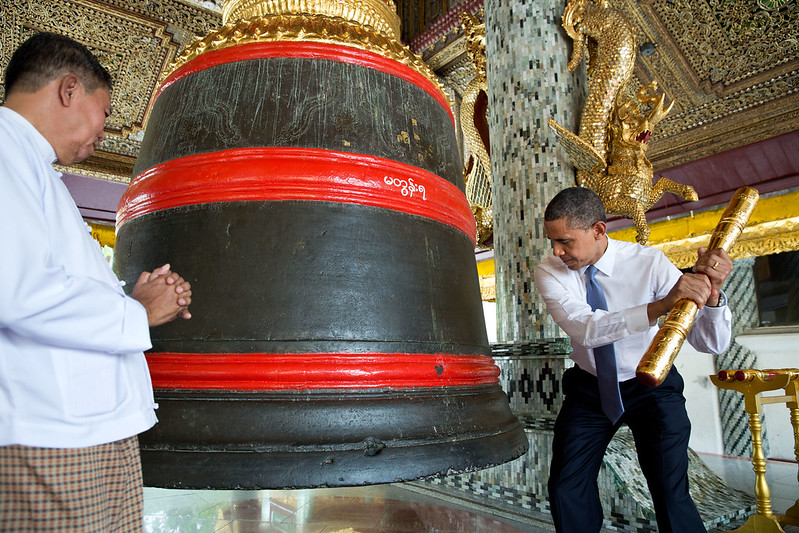
What have we learned? That when our body and mind are not at peace, when there is discord, when we suffer, we have to play music. Perhaps this is why there is so much chanting in temples. Not all temples have a clear path of practice, but when it’s time for chanting, everyone comes together in harmony. Everyone is concentrated on the music, and that hour of chanting may be the most beautiful moments in the temple’s day. But we are not a temple, we are a practice center, so not only are we united while we are sitting and chanting, but also when we cook, work, or clean the meditation hall. We do it in mindfulness, so the music of the practice follows us the whole day, helping all the cells in our body, all the mental formations to go in the same direction, and they are always present with us, in the same way that the American people are there behind Obama during his inauguration. We have to maintain this unity hour by hour, day by day. That is the meaning of “mindfulness, concentration and insight”.
Our practice must be pleasant and skillful to appeal to all of our five skandhas (our body, feelings, perceptions, mental formations and consciousness). If we want to receive the support of the majority, like Obama did with his speech, we have to speak to the real situation within ourselves, and inspire faith and cooperation.
So the work of President Obama is not so different from our own. We can apply the practice within our own family, our own sangha; and we need to succeed. If politicians can have a spiritual dimension, they will have more strength. President Obama does have something akin to a spiritual dimension. In his speech, he even used the word “mindful.” Everyone reported that his face was calm and serene. The French journalists used the phrase “the power of calm” (“la force tranquil”). Very interesting! Maybe someone can send President Obama a copy of Thay’s book, The Miracle of Mindfulness. Who knows, he might have read it already.
If you would like to find a sangha or practice group to sit together with, you can find one here. (Many sanghas are meeting online during Covid-19 restrictions.)


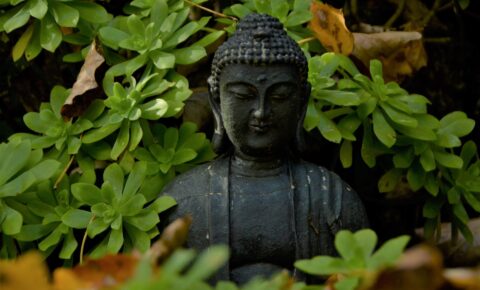

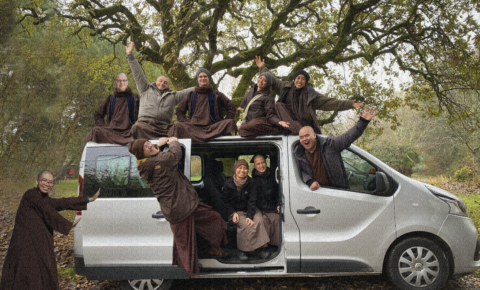
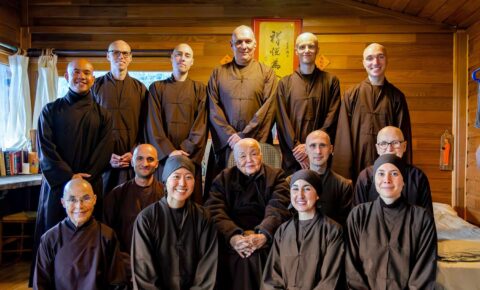
Join the conversation